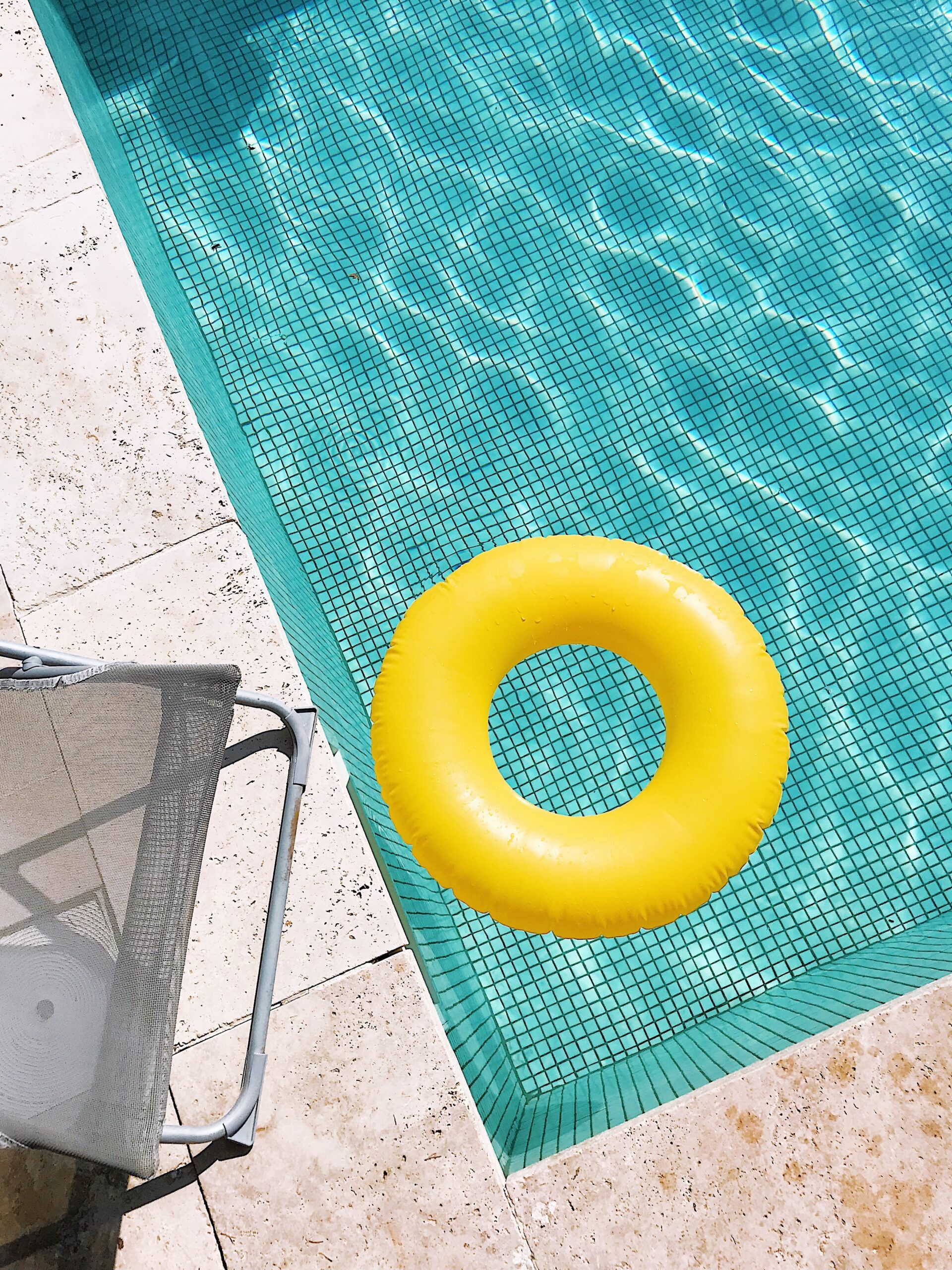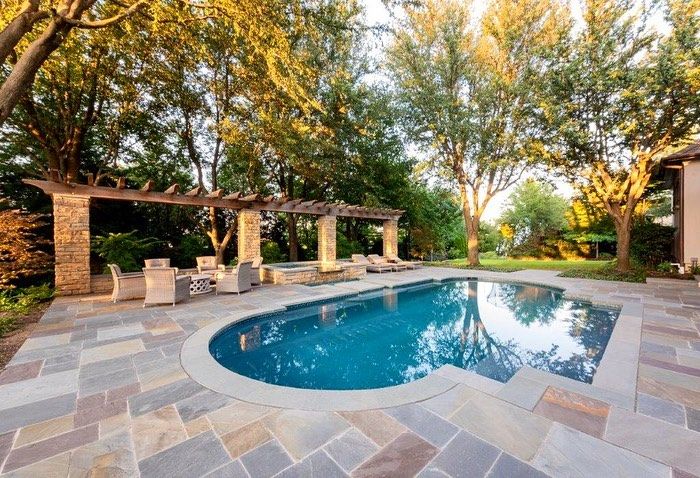Are you struggling with a green pool? Don't worry, we've got you covered.
In this informative article, we will provide you with a step-by-step guide on how to effectively clear a green pool and prevent future occurrences.
From understanding the causes of green pool water to using chlorine shock and additional measures like algaecide and flocculant, we will equip you with the knowledge and techniques needed to restore your pool to its crystal-clear state.
Say goodbye to algae and enjoy a safe swimming experience.
Key Takeaways
- Algae is the main cause of green pool water and can enter the pool through debris, swimsuits, or pool toys.
- Factors such as insufficient water testing and sanitation, low sanitizer and chlorine levels, and extreme weather conditions contribute to algae growth.
- It is important to assess the severity of the green color and condition of the filters before considering draining the pool.
- Testing and adjusting the pH levels, shocking the pool with chlorine, and using algaecide and flocculant can help clear green pool water, while regular maintenance and prevention measures are crucial for avoiding future algae growth.
Understanding the Causes of Green Pool Water
Understanding the causes of green pool water is essential in effectively addressing and preventing this issue. The main culprit for green pool water is algae, which can enter the pool through debris, swimsuits, or pool toys. Algae thrives in water that contains nitrogen and phosphorus, making it important to maintain proper water testing and sanitation. Insufficient testing and low sanitizer and chlorine levels create a hospitable environment for algae growth. Additionally, factors such as extreme heat, high winds, a dirty pool, incorrect pH levels, clogged filters, and rainstorms increase the likelihood of algae blooms.
To assess the situation, it is crucial to determine if the pool needs to be drained based on the intensity of the green color. If the water is still somewhat transparent, draining may not be necessary. It is also important to check the condition of the filters during the assessment and clean them if needed.
pH testing is another crucial step in addressing green pool water. Using a reliable testing kit, the pH levels should be tested and adjusted accordingly. Balancing the pH is crucial to prevent cloudy water after shocking. pH adjustment chemicals can be used to increase or decrease pH levels, with a target pH level of 7.2 or lower. It is recommended to use a quality liquid testing kit for accurate results, as an imbalance of pH levels can contribute to green pool water.
To effectively clear green pool water, several steps need to be taken. Firstly, the situation should be assessed to determine if draining is necessary. Then, the pH levels should be tested and adjusted. Next, the pool should be shocked with a high concentration of chlorine. The filter should be allowed to clean out the dead algae, and algaecide and flocculant can be used to prevent future algae growth. It is important to note that insufficient chlorine levels can lead to green pool water.
To prevent and maintain clear pool water, regular maintenance is key. This includes cleaning pool filters regularly, skimming the pool surface to remove debris and leaves, maintaining proper water circulation and filtration, and regularly shocking the pool to prevent algae growth. Keeping the pool covered when not in use can also minimize environmental factors that contribute to green pool water.
Assessing the Severity of the Algae Bloom
To accurately assess the severity of the algae bloom, it is important to observe the color and density of the green pool water. The depth of the green color indicates the intensity of the algae bloom. A darker shade of green suggests a more severe bloom, while a lighter shade indicates a less severe one. The density of the water can also provide valuable information. If the water is murky and thick, it suggests a high concentration of algae, indicating a more significant bloom.
In addition to visual observation, it is crucial to consider the possible causes of the green pool. Factors such as insufficient water testing and sanitation, low sanitizer and chlorine levels, extreme weather conditions, a dirty pool, and clogged filters can contribute to the growth of algae. Understanding these causes can help in assessing the severity of the algae bloom and developing an effective plan for clearing the green pool.
Once the severity of the algae bloom has been assessed, appropriate steps can be taken to clear the green pool. These steps may include testing and adjusting the pH levels, shocking the pool with a high concentration of chlorine, allowing the filter to clean out the dead algae, and using algaecide and flocculant to prevent future algae growth.
Ph Testing and Adjustment for Clearing Green Pool Water
Maintaining the proper pH balance in a pool is essential for clearing green pool water. The pH level affects the effectiveness of chlorine and other sanitizers in killing algae.
Testing the pH levels using a reliable testing kit and adjusting them to 7.2 or below is crucial.
Various pH adjustment techniques, such as using pH adjustment chemicals, can help restore the balance and facilitate the clearing process.
Importance of Ph Balance
The importance of maintaining proper pH balance in a pool cannot be overstated when it comes to effectively testing and adjusting the pH levels to clear green pool water. A balanced pH level ensures that the pool water is neither too acidic nor too alkaline, which is crucial for preventing the growth of algae and other contaminants.
Here are three reasons why maintaining proper pH balance is essential for pool water balance:
- Prevents Algae Growth: Algae thrives in unbalanced pool water, especially in water that is too acidic. By keeping the pH level within the recommended range of 7.2 or lower, you can inhibit the growth of algae and prevent your pool water from turning green.
- Maximizes Sanitizer Efficiency: Proper pH balance allows the pool's sanitizer, such as chlorine, to work effectively. When the pH is too high or too low, the sanitizer's ability to kill bacteria and algae is compromised, leading to cloudy and green pool water.
- Protects Pool Equipment: Imbalanced pH levels can cause corrosion and damage to pool equipment, including filters, pumps, and heaters. By maintaining the correct pH balance, you can prolong the lifespan of your pool equipment and avoid costly repairs or replacements.
Ph Adjustment Techniques
A crucial step in clearing green pool water is performing regular pH testing and making necessary adjustments using appropriate techniques. pH levels play a significant role in pool water quality and can contribute to the development of green water.
Testing the pH levels using a reliable testing kit is essential to accurately assess the acidity or alkalinity of the water. pH adjustment chemicals can then be used to increase or decrease the pH levels accordingly. It is recommended to aim for a pH level of 7.2 or lower to prevent cloudy water after shocking. An imbalance in pH levels can cause green pool water.
Steps to Clear Green Pool Water
Effective treatment is essential when attempting to clear green pool water. Follow these steps to effectively treat and clear green pool water:
- Assess the situation: Determine the severity of the green color and assess the condition of the filters. If the water is still somewhat transparent and the filters are in good condition, draining may not be necessary. Cleaning the filters before proceeding with the treatment process is recommended.
- Test and adjust pH levels: Use a reliable testing kit to test the pH levels of the pool water. Balancing the pH is crucial to prevent cloudy water after shocking. Adjust the pH levels using appropriate chemicals to achieve a pH level of 7.2 or below. Imbalance of pH levels can contribute to green pool water.
- Shock the pool: Shocking the pool involves adding a high concentration of chlorine to kill the algae. Follow the manufacturer's instructions for the appropriate amount of shock treatment based on the size of your pool. This will help eliminate the algae and restore the water clarity.
- Filter and clean: Allow the filter to run continuously to clean out the dead algae. Backwash or clean the filter regularly to ensure proper functioning. Skim the pool surface to remove any debris or leaves that may contribute to the growth of algae.
- Prevent future algae growth: Consider using algaecide and flocculant products to prevent future algae growth. These products help to inhibit the growth of algae and improve water clarity. Regularly maintaining proper water circulation, filtration, and shocking the pool will also help prevent the recurrence of green pool water.
Using Chlorine Shock to Eliminate Algae
To effectively eliminate algae and clear a green pool, using chlorine shock is a recommended method.
Chlorine shock is a powerful treatment that helps to kill and remove algae from the pool water.
Proper Chlorine Concentration
Successfully eliminating algae from a green pool requires using the proper concentration of chlorine shock. Chlorine shock is a powerful treatment that effectively kills algae and restores the pool water to its clear state. To ensure the proper chlorine concentration, follow these guidelines:
- Determine the current chlorine level in the pool using a testing kit.
- Calculate the required amount of chlorine shock based on the pool size and severity of the algae bloom.
- Add the chlorine shock slowly and evenly around the pool to distribute it effectively.
Maintaining the proper chlorine concentration is essential for effective pool algae control. Too little chlorine may not kill the algae, while too much chlorine can be harmful to swimmers and damage pool surfaces. Regularly testing and adjusting the chlorine levels will help keep the pool water clear and algae-free.
When to Shock?
Determining the appropriate time to shock the pool with chlorine is crucial for effectively eliminating algae and restoring the water to its pristine condition. Shocking the pool involves adding a high concentration of chlorine to kill the algae and bacteria present in the water. This process should be done when other pool water treatment methods, such as balancing the pH and ensuring proper filtration, have been completed. It is important to shock the pool when the algae bloom is severe and the water appears green and cloudy. However, it is recommended to consult with a pool professional or use a water testing kit to determine the exact timing and amount of chlorine shock needed. The table below provides a general guideline for determining when to shock the pool:
| Pool Water Condition | Appropriate Time to Shock |
|---|---|
| Clear water | Not necessary |
| Slightly cloudy | Not necessary |
| Green water | Shock immediately |
| Cloudy water | Shock immediately |
| Black or dark green | Shock immediately |
Additional Measures: Algaecide and Flocculant
The application of algaecide and flocculant can be effective in clearing a green pool. Algaecide is a chemical specifically designed to kill and prevent the growth of algae in the pool water. It works by breaking down the cell walls of the algae, making it easier for the chlorine to kill them. Flocculant, on the other hand, is a chemical that helps to clump together the fine particles and debris in the water, making it easier for the filter to remove them.
Using algaecide and flocculant as part of the pool cleaning process can provide additional benefits.
- Algaecide helps to kill any remaining algae in the water, preventing them from regrowing and causing the pool to turn green again.
- Flocculant helps to remove the fine particles that may not be effectively filtered out by the pool's filtration system.
- Together, algaecide and flocculant can enhance the effectiveness of chlorine in killing algae and improving water clarity.
After applying algaecide and flocculant, it is important to allow the chemicals to circulate in the pool for a few hours before running the filtration system. This will give them enough time to work and settle the debris to the bottom of the pool. Once the debris has settled, it can be vacuumed or manually removed from the pool.
By incorporating the use of algaecide and flocculant in the cleaning process, you can effectively eliminate algae and improve the overall clarity of your pool water.
Now let's move on to the next section, which will provide prevention and maintenance tips to help keep your pool clear and free from algae.
Prevention and Maintenance Tips for a Clear Pool
To maintain a clear pool, it is important to regularly clean and balance the water chemistry. By following these prevention and maintenance tips, you can ensure that your pool remains crystal clear and inviting for swimming.
One of the key steps in maintaining a clear pool is to clean the pool filters regularly. The filters play a crucial role in removing debris and contaminants from the water, so it is important to keep them in good working condition. Regularly skimming the pool surface to remove leaves and other debris is also important to prevent the buildup of organic matter that can contribute to algae growth.
Proper water circulation and filtration are essential for a clear pool. This can be achieved by ensuring that the pool pump is running efficiently and that the water is circulating properly. Regularly checking and cleaning the pump and skimmer baskets will help to maintain optimal circulation and filtration.
Regularly shocking the pool is another important step in preventing algae growth and maintaining water clarity. Shocking the pool involves adding a high concentration of chlorine to kill any bacteria, algae, and other contaminants that may be present in the water. It is recommended to shock the pool at least once a week, or more frequently if the pool is heavily used.
Keeping the pool covered when not in use can also help to prevent environmental factors, such as sunlight and debris, from entering the pool and causing algae growth. Additionally, regular maintenance, such as brushing the pool walls and floor, and checking and adjusting the water chemistry, will help to prevent the buildup of algae and other contaminants.
Frequently Asked Questions
Can I Use Natural or Homemade Remedies to Clear a Green Pool?
Natural or homemade remedies may not be sufficient to clear a green pool effectively. Green pool water is typically caused by algae growth, which requires specific treatment. While some natural remedies, such as using hydrogen peroxide or baking soda, may have some mild effects, they may not fully eliminate the algae and restore water clarity.
It is recommended to follow proven methods such as testing and adjusting pH levels, shocking the pool with chlorine, and using algaecide and flocculant to effectively clear a green pool.
How Long Does It Usually Take to Clear a Green Pool?
On average, it can take anywhere from a few days to a few weeks to clear a green pool, depending on the severity of the algae bloom and the effectiveness of the cleaning process. Clearing a green pool involves steps such as testing and adjusting the pH levels, shocking the pool with chlorine, and allowing the filter to remove dead algae.
Regular maintenance and prevention measures can help minimize the occurrence of green pool water. These measures include proper filtration and regular shock treatments. By regularly maintaining the pool and taking preventive actions, the chances of experiencing a green pool are reduced.
Is It Safe to Swim in a Pool That Has Been Treated With a High Concentration of Chlorine?
Swimming in a pool that has been treated with a high concentration of chlorine can be safe, as long as the chlorine levels are within the recommended range. It is important to test the water regularly to ensure the chlorine levels are balanced.
High levels of chlorine can cause skin and eye irritation, so it is advisable to wait until the chlorine levels have returned to normal before swimming.
Following proper water maintenance and testing procedures will help ensure the safety and enjoyment of the pool.
Can I Use Vinegar or Baking Soda to Adjust the Ph Levels of My Pool?
Yes, vinegar or baking soda can be used to adjust the pH levels of a pool.
Vinegar, which is acetic acid, can lower the pH level if it is too high.
Baking soda, which is sodium bicarbonate, can raise the pH level if it is too low.
However, it is important to note that the use of vinegar or baking soda may not be sufficient to fully balance the pH levels of the pool, especially in cases of severe pH imbalance.
It is recommended to use pH adjustment chemicals specifically designed for pool use for more accurate and effective results.
Are There Any Specific Types of Pool Filters That Are More Effective in Preventing Algae Growth?
When it comes to preventing algae growth in a pool, the effectiveness of different types of pool filters can vary. While there is no specific type of pool filter that guarantees complete prevention of algae growth, certain filters, such as cartridge filters and diatomaceous earth (DE) filters, are known for their superior filtration capabilities.
These filters can effectively remove even the smallest particles and debris from the pool water, reducing the chances of algae formation. Regular cleaning and maintenance of the filters are essential to ensure their optimal performance in preventing algae growth.




